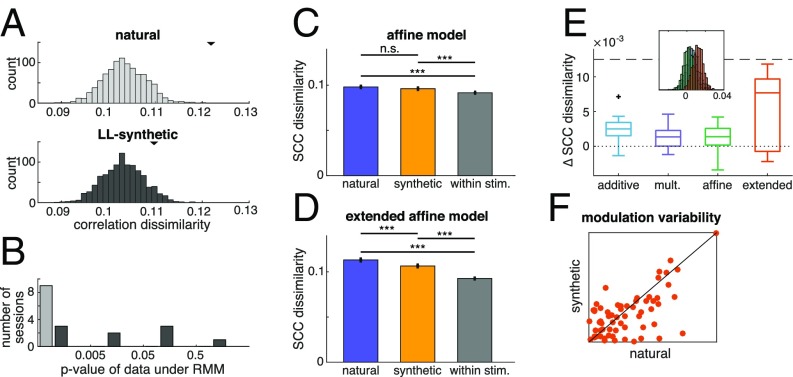Fig. 6.
(A) Raster marginal models (RMMs) fitted to the spike trains recorded in response to natural images and to LL-synthetic images in an example session (Top and Middle, respectively). Distributions of dissimilarities are calculated between correlation matrices sampled from RMMs obtained from the population activities recorded for individual stimuli. Black triangles mark the mean dissimilarity calculated from the electrophysiological data. (B) Likelihoods of recorded dissimilarity under the RMM model in all of the sessions in the natural and LL-synthetic conditions (colors match those of the Top and Middle). Dissimilarity indices of 500 pairs of correlation matrices sampled from the RMM model were used to assess the likelihood of the recorded data. Stimulus dependence of correlation matrices under natural image stimulation could not be explained by an RMM model in any of the recorded sessions. Dissimilarity determined for LL-synthetic stimuli was significantly different from the RMM model in five out of nine sessions. (C–F) Analysis of the joint-fluctuation models (JFMs). (C) SCC dissimilarity of synthetic data generated from the affine model fitted to an example recording session. SCC shows stimulus specificity both for synthetic and natural stimuli, but stimulus specificity of SCCs is not significantly different for synthetic and natural stimuli. (D) Same as C but for the extended affine model. Stimulus-specific additive component introduces sensitivity to the covariance structure characteristic of the responses of natural images, which supports a difference in SCC dissimilarity between natural and synthetic stimuli. (E) Multiple simulations with the same parameters yield a distribution of differences between SCC dissimilarities (Inset, colors of example models match those in the main panel). Sensitivity of the JFMs to differences in natural and synthetic stimuli was measured by the mean of the differences calculated for every given session was calculated for the four JFMs. (F) Comparison of stimulus specificity of parameters in the extended affine model for natural and LL-synthetic stimuli. Variability of the weight of the stimulus-specific additive component was measured. Individual points represent separate channels. All recording sessions are included.

